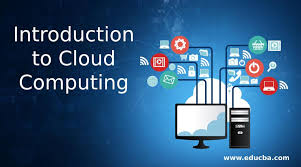Introduction to Cloud Computing
 techGyan : smart tech study
techGyan : smart tech study
Introduction
Cloud computing has revolutionized the way businesses and individuals store, manage, and process data. It provides on-demand access to computing resources over the internet, eliminating the need for extensive on-premises infrastructure. Instead of maintaining expensive servers and hardware, organizations can leverage cloud services for scalability, efficiency, and cost-effectiveness.
Why is Cloud Computing Important?
With the rise of digital transformation, cloud computing has become a crucial component across various sectors, including:
✅ IT Industry – Enables developers and businesses to deploy applications faster with cloud-based hosting, databases, and AI services.
✅ Healthcare – Enhances patient data management, remote consultations, and secure storage of medical records.
✅ Education – Facilitates online learning platforms, virtual classrooms, and collaboration tools for students and teachers.
✅ Finance – Provides secure transaction processing, fraud detection, and real-time data analytics for better decision-making.
At TechGyan, we emphasize the power of cloud computing in shaping the future of technology. Whether you're a developer, entrepreneur, or enthusiast, embracing cloud solutions can drive innovation and growth in your domain. 🚀
Stay tuned with TechGyan for more insights into cutting-edge technologies! 💡
Evolution of Cloud Computing

A Historical Perspective on Cloud Computing The concept of cloud computing has evolved over several decades, tracing its roots back to the 1960s when John McCarthy suggested that computing could be sold as a utility. The following are key milestones in the evolution of cloud computing:
1960s-1970s: Emergence of time-sharing and virtualization technologies.
1980s: Introduction of client-server computing and early networking models.
1990s: Growth of internet-based services and application service providers (ASPs).
2000s: Amazon Web Services (AWS) launched in 2006, introducing cloud-based infrastructure services.
2010s-Present: Rapid expansion of cloud platforms like Google Cloud, Microsoft Azure, and hybrid cloud solutions.
Cloud Computing Overview

Understanding the Basics of Cloud Computing Cloud computing provides scalable and flexible computing resources over the internet. It is categorized into three main service models:
Infrastructure as a Service (IaaS): Provides virtualized computing resources such as storage, networking, and virtual machines (e.g., AWS EC2, Google Compute Engine).
Platform as a Service (PaaS): Offers a development platform with built-in infrastructure, allowing developers to focus on coding without managing the underlying hardware (e.g., Google App Engine, Microsoft Azure App Services).
Software as a Service (SaaS): Delivers software applications over the internet, eliminating the need for local installation (e.g., Google Drive, Microsoft Office 365).
Characteristics of Cloud Computing
Key Features that Define Cloud Computing Cloud computing exhibits several defining characteristics:
On-Demand Self-Service: Users can provision resources without human intervention.
Broad Network Access: Services are accessible from various devices via the internet.
Resource Pooling: Computing resources are shared among multiple users dynamically.
Rapid Elasticity: Resources scale up or down based on demand.
Measured Service: Users pay only for the resources they consume.
Applications of Cloud Computing
How Cloud Computing is Transforming Industries Cloud computing is widely used across different industries, including:
Business and Enterprise: Cloud-based collaboration tools, CRM systems (e.g., Salesforce), and ERP solutions.
Healthcare: Secure data storage, telemedicine platforms, and AI-driven diagnostics.
Education: Online learning platforms, virtual classrooms, and e-libraries.
Entertainment: Streaming services like Netflix and gaming platforms like Google Stadia.
Finance: Online banking, fraud detection, and financial modeling.
Benefits of Cloud Computing
Why Businesses and Individuals Prefer Cloud Computing The adoption of cloud computing offers numerous advantages:
Cost Savings: Reduces capital expenditure on IT infrastructure.
Scalability: Allows businesses to scale resources according to needs.
Flexibility: Enables remote access to data and applications.
Security: Offers robust security features like encryption and identity management.
Disaster Recovery: Ensures data redundancy and quick recovery in case of failures.
Challenges of Cloud Computing

Common Issues and Risks in Cloud Adoption Despite its advantages, cloud computing faces certain challenges:
Security Concerns: Data privacy and cyber threats remain significant concerns.
Downtime Risks: Service interruptions may occur due to outages.
Compliance Issues: Organizations must adhere to regulatory requirements.
Vendor Lock-In: Dependency on a single cloud provider can limit flexibility.
Data Management: Handling large volumes of cloud-stored data can be complex.
Conclusion
Cloud computing is revolutionizing the digital landscape, continuously evolving to offer cutting-edge solutions for businesses and individuals. By understanding its core characteristics, applications, benefits, and challenges, organizations can harness cloud technologies to drive innovation and operational efficiency.
At TechGyan, we explore how cloud computing is shaping the future. Emerging trends such as artificial intelligence (AI), edge computing, and serverless architectures are set to redefine how businesses deploy, manage, and scale their operations. With ongoing advancements, cloud solutions will become more intelligent, efficient, and secure, unlocking limitless possibilities for the tech industry.
Stay tuned with TechGyan as we delve deeper into the future of cloud computing and how you can stay ahead in this rapidly transforming digital era. 🚀
Subscribe to my newsletter
Read articles from techGyan : smart tech study directly inside your inbox. Subscribe to the newsletter, and don't miss out.
Written by

techGyan : smart tech study
techGyan : smart tech study
TechGyan is a YouTube channel dedicated to providing high-quality technical and coding-related content. The channel mainly focuses on Android development, along with other programming tutorials and tech insights to help learners enhance their skills. What TechGyan Offers? ✅ Android Development Tutorials 📱 ✅ Programming & Coding Lessons 💻 ✅ Tech Guides & Tips 🛠️ ✅ Problem-Solving & Debugging Help 🔍 ✅ Latest Trends in Technology 🚀 TechGyan aims to educate and inspire developers by delivering clear, well-structured, and practical coding knowledge for beginners and advanced learners.